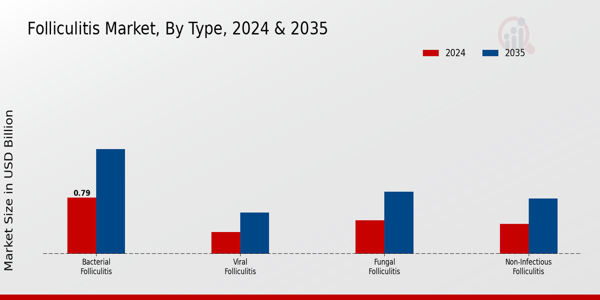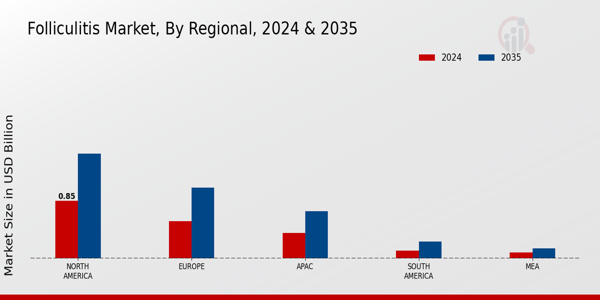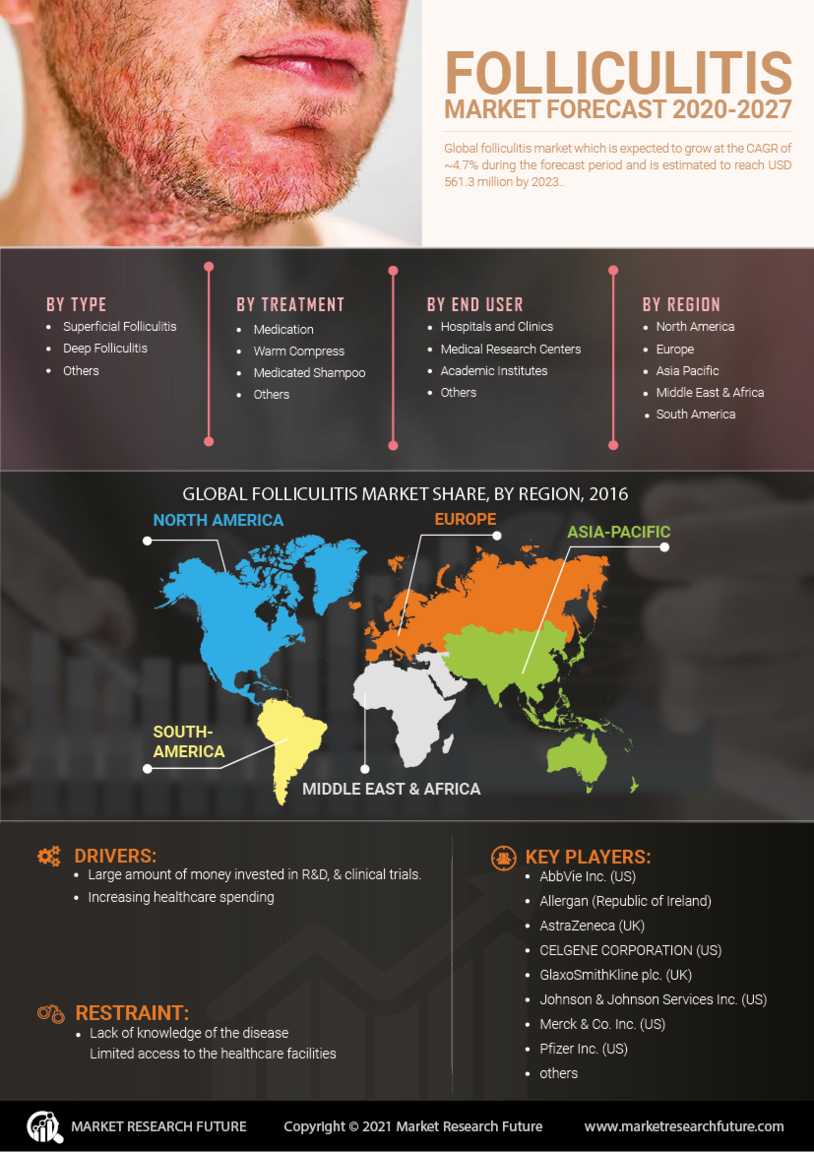Folliculitis Market Overview
As per MRFR analysis, the Folliculitis Market Size was estimated at 1.88 (USD Billion) in 2023. The Folliculitis Market Industry is expected to grow from 1.99(USD Billion) in 2024 to 3.7 (USD Billion) by 2035. The Folliculitis Market CAGR (growth rate) is expected to be around 5.81% during the forecast period (2025 - 2035).
Key Folliculitis Market Trends Highlighted
The Global Folliculitis Market is experiencing several notable trends driven by increasing awareness of skin health and advancements in dermatological treatments. The rising incidence of skin disorders, particularly folliculitis, has emphasized the need for effective treatment solutions. Growing consumer awareness regarding personal hygiene and skin care has boosted demand for antifungal and antibacterial products used in treating folliculitis. The advent of telemedicine and online consultations has also transformed how patients access dermatological care, making it easier for individuals to seek treatment and guidance remotely.
Opportunities exist for pharmaceutical companies to develop innovative therapies targeting both prevention and treatment of folliculitis, with a focus on personalized medicine approaches.The expanding elderly population globally, who are more susceptible to skin issues, presents a significant market opportunity for products designed to address this demographic's specific needs. Additionally, the rise in health and wellness trends aligns with consumer interest in natural and organic skincare solutions, paving the way for the introduction of new, holistic products that can treat folliculitis while also promoting overall skin health.
Recent times have seen a shift towards more holistic and integrative approaches in managing skin conditions, emphasizing the importance of lifestyle, nutrition, and environmental factors in skin health.This trend reflects broader movements in global healthcare emphasizing preventive measures and comprehensive care. The rise of platforms advocating for mental wellness and stress reduction is also fostering interest in the interconnectivity between psychological well-being and skin conditions. As a result, the Global Folliculitis Market is positioned for dynamic growth, driven by these trends and the ongoing demand for effective and innovative treatment options.

Source: Primary Research, Secondary Research, MRFR Database and Analyst Review
Folliculitis Market Drivers
Increasing Prevalence of Skin Disorders
The rising incidence of skin problems, especially those that result in folliculitis, is a major factor propelling the global folliculitis market industry. The World Health Organization (WHO) estimates that folliculitis is one of the common skin illnesses that affect over 900 million people worldwide. Pharmaceutical firms and dermatological organizations are being encouraged to participate in research and development (R&D) projects because to the increasing need for improved medical treatments and goods.
Furthermore, the availability of dermatological therapies is becoming more and more important as global healthcare systems advance. The American Academy of Dermatology, for example, has seen a growth in skin conditions and predicts that by 2030, the number of skin diseases will continue to climb, increasing the need for efficient folliculitis treatments throughout the world.
Advancements in Medical Technologies
Technological advancements in the medical field, particularly in dermatology, are significantly influencing the Global Folliculitis Market Industry. Innovations such as laser therapies, advanced topical therapies, and new antibiotics are redefining treatment protocols for folliculitis, making them more effective and accessible. The International Society of Dermatology has noted that recent developments in minimally invasive treatments are being adopted globally.As technologies improve and patient outcomes enhance, healthcare providers are more likely to integrate these advanced treatments into their practice.
Moreover, the global market for medical technologies is projected to grow, driven by an increase in healthcare expenditure, which is expected to reach approximately USD 8.3 trillion by 2027, fostering greater investment into folliculitis treatment methodologies.
Growing Awareness and Patient Education
There is a growing awareness and patient education surrounding folliculitis and related skin disorders, which acts as a key driver in the Global Folliculitis Market Industry. Campaigns initiated by organizations such as the National Eczema Association aim to educate the public about skin health, resulting in more individuals seeking treatment for their conditions. Studies have indicated that educated patients are more likely to seek medical advice and treatment early, thus increasing the overall treatment market.Moreover, the rise of digital health platforms and online resources has enabled patients to access information rapidly, leading to a broader acceptance of dermatological consultations and treatments. As a result, the demand for folliculitis treatments is expected to rise, propelling market growth in the coming years.
Folliculitis Market Segment Insights
Folliculitis Market Type Insights
The Global Folliculitis Market showcases significant growth trends and diversification within its Type segment, comprising Bacterial Folliculitis, Fungal Folliculitis, Viral Folliculitis, and Non-Infectious Folliculitis. In 2024, the complete market is valued at 1.99 USD Billion and is projected to reach 3.7 USD Billion by 2035. Bacterial Folliculitis is the dominant segment, holding a valuation of 0.79 USD Billion in 2024 and expected to rise to 1.47 USD Billion in 2035, accounting for a majority holding within the market. This sub-segment is significant due to the increasing prevalence of bacterial infections and a growing awareness among consumers regarding skin health. Fungal Folliculitis, with a valuation of 0.47 USD Billion in 2024 and rising to 0.87 USD Billion by 2035, is experiencing attention, especially among populations at risk, such as those with compromised immune systems.
It represents a noteworthy opportunity for healthcare providers to cater to growing public health concerns associated with fungal infections. Meanwhile, Viral Folliculitis retains a smaller share, valued at 0.31 USD Billion in 2024 and projected to grow to 0.58 USD Billion in 2035, highlighting its lesser but important role in public health discourse, particularly in relation to viral skin diseases and their treatments.On the other hand, Non-Infectious Folliculitis accounts for a valuation of 0.42 USD Billion in 2024, which is expected to increase to 0.78 USD Billion in 2035.
The non-infectious nature of this condition underscores the need for innovative treatment options and awareness programs to educate the public, ensuring that people understand this form as both an aesthetic and medical concern. Overall, the Global Folliculitis Market segmentation illustrates diverse underlying health concerns, treatment advancements, and opportunities for future growth within the industry, presenting a robust landscape for stakeholders to explore.

Source: Primary Research, Secondary Research, MRFR Database and Analyst Review
Folliculitis Market Treatment Method Insights
The Global Folliculitis Market is projected to witness robust growth, supported by the diverse range of treatment methods used to address this dermatological condition. In 2024, the overall market is valued at 1.99 USD Billion, with a broadened focus on treatment methods that include Topical Antibiotics, Oral Antibiotics, Antifungal Medications, Steroid Injections, and Laser Therapy. Each of these treatment methods plays a critical role in managing folliculitis, with Topical Antibiotics often being the first line of defense due to their effectiveness and ease of application.
Oral Antibiotics cater to more severe cases, making them significant for patients with persistent symptoms. Antifungal Medications are essential for cases arising from fungal infections, illustrating the importance of targeted therapies. Steroid Injections provide rapid inflammation relief, while Laser Therapy is gaining traction for its advanced approach to treating recurrent folliculitis, showing promising results. As part of the Global Folliculitis Market segmentation, these methods reveal significant opportunities and trends that drive market expansion, making it crucial to continually adapt to emerging treatment options and technologies.Market growth is further supported by increasing healthcare expenditure and advancements in dermatological therapies across the globe.
Folliculitis Market End User Insights
The Global Folliculitis Market revenue is poised for growth, with the valuation reaching 1.99 billion USD in 2024. The End User segment encompasses diverse settings, including hospitals, dermatology clinics, and home care settings, each playing a vital role in combating folliculitis. Hospitals continue to be a crucial point of care, offering specialized treatment and interventions, while dermatology clinics provide targeted care and expertise essential for the effective management of this skin condition.
Home care settings are gaining prominence as patients increasingly prefer convenience and comfort in managing their conditions, facilitated by advancements in home care treatments and monitoring technologies.As the market growth is driven by increasing incidences of folliculitis, rising awareness regarding skin health, and advancements in treatment methods, these End User settings are significant members of the market. Moreover, the Global Folliculitis Market statistics exhibit a trend towards integrated care approaches across these sectors, enhancing accessibility and improving patient outcomes, aligning with broader healthcare trends towards personalized and patient-centered care.
Folliculitis Market Distribution Channel Insights
The Global Folliculitis Market experienced significant growth, with expectations of reaching a value of 1.99 billion USD in 2024. This market is primarily segmented by Distribution Channel, which plays a crucial role in how products reach consumers. Pharmacies serve as a traditional and trusted source for patients seeking treatment for folliculitis, allowing for personalized consultation and immediate access to medications. Online Pharmacies, on the other hand, are gaining traction due to convenience and the increasing digitalization of shopping habits, particularly post-pandemic, thus expanding the reach to consumers who prefer discreet and quick purchasing options.
Health and Wellness Stores contribute by offering specialized products focusing on hygiene and skin care, appealing to health-conscious consumers. As global awareness of skin health grows, especially across regions with prevalent dermatological concerns, the importance of these channels is underscored. The interplay between these distribution avenues significantly enhances accessibility and choice for patients, driving the overall Global Folliculitis Market growth and ensuring diverse options for treatment.
Folliculitis Market Regional Insights
The Regional segment of the Global Folliculitis Market showcases a diversified landscape characterized by distinct contributions from various regions. North America leads with a market valuation of 0.85 USD Billion in 2024, projected to rise to 1.55 USD Billion by 2035, reflecting its majority holding in the market. This dominance can be attributed to advanced healthcare infrastructure and a growing awareness of skin-related conditions. Europe follows, with values of 0.55 USD Billion in 2024 and an estimated 1.05 USD Billion in 2035, benefiting from robust Research and Development initiatives and innovative treatment solutions.
The APAC region, valued at 0.38 USD Billion in 2024 and expected to grow to 0.7 USD Billion by 2035, is gaining traction due to increasing urbanization and rising disposable incomes, driving demand for effective folliculitis treatments. South America, with a valuation of 0.12 USD Billion in 2024 and MEA at 0.09 USD Billion, represent smaller but significant markets with potential for growth, largely due to increasing health awareness and expanding healthcare access. Overall, the Global Folliculitis Market segmentation highlights important regional dynamics, pointing to growth opportunities driven by varying healthcare trends and consumer behaviors across the globe.

Source: Primary Research, Secondary Research, MRFR Database and Analyst Review
Folliculitis Market Key Players and Competitive Insights
The competitive landscape of the Global Folliculitis Market is characterized by a blend of pharmaceutical companies focusing on developing effective treatments for skin conditions, specifically targeting the folliculitis condition. The market is driven by rising incidences of skin infections, increased awareness about dermatological issues, and the growing demand for effective therapeutics. Companies operating in this sector are investing heavily in research and development to innovate and provide advanced solutions. Competitive strategies, including collaborations, partnerships, and mergers, are prevalent as companies aim to enhance their market share and expand their product portfolios.
Additionally, regulatory frameworks and market dynamics must be navigated carefully to maintain compliance and address the needs of healthcare professionals and patients alike.Pfizer, a major player in the Global Folliculitis Market, boasts a robust presence thanks to its extensive portfolio of dermatological products. The company's strengths lie in its strong research capabilities, established brand reputation, and commitment to quality, making it a trusted name among healthcare providers. Pfizer focuses on developing advanced treatments that address both the prevention and management of folliculitis, leveraging its wide distribution network to ensure that its products are accessible worldwide.
This capability not only solidifies its market presence but also emphasizes its dedication to addressing patient needs through innovation. Pfizer's investment in clinical trials and collaborations with dermatology specialists further enhances its positioning within the global market.Merck and Co is another significant entity in the Global Folliculitis Market, recognized for its comprehensive offerings in medical treatments and skin health solutions. With a diverse range of products designed for the treatment of folliculitis, the company benefits from a strong market presence, reinforced by its reputation for quality and effectiveness.
Merck focuses on innovative therapies that address various manifestations of skin conditions, ensuring its competitive edge. The company has engaged in strategic mergers and acquisitions to strengthen its product pipeline and expand its market reach. By enhancing its research and development capabilities, Merck and Co. is committed to delivering solutions that meet not only current market demands but also anticipate future trends in dermatological care, thereby securing its position as a leader in the global foliculitis market.
Key Companies in the Folliculitis Market Include
- Pfizer
- Merck and Co
- AbbVie
- Sun Pharmaceutical Industries
- Eli Lilly
- Johnson and Johnson
- Teva Pharmaceutical Industries
- Novartis
- Mylan
- Hikma Pharmaceuticals
- Bayer
- AstraZeneca
- GlaxoSmithKline
- Amgen
- Sanofi
Folliculitis Market Industry Developments
Recent developments in the Global Folliculitis Market indicate significant advancements and activities among key players like Pfizer, Merck and Co, AbbVie, and others. Growth in their market valuation has been driven by increasing demand for effective treatments, contributing to a robust market landscape. In September 2023, Pfizer announced a strategic collaboration with a biotechnology firm to enhance its Research and Development capabilities for skin-related disorders, positioning itself to maximize market penetration. Meanwhile, in August 2023, AbbVie revealed a plan to expand its dermatology portfolio, aligning with growing consumer and clinical needs for targeted folliculitis therapies.
Additionally, Merck and Co have been focusing on increasing its manufacturing efforts to meet the rising market demands, reflecting positive trends for various dermatological treatments. Over the past two years, the Global Folliculitis Market saw notable mergers, including the acquisition of a niche dermatological firm by Eli Lilly in February 2022, aimed at enriching its product offerings. The ongoing investments and collaborative efforts among companies like Johnson and Johnson, Teva Pharmaceutical Industries, and Novartis underscore a dynamic shift toward innovative solutions in this sector, reinforcing the competitive landscape of the Global Folliculitis Market.
Folliculitis Market Segmentation Insights
Folliculitis Market Type Outlook
- Bacterial Folliculitis
- Fungal Folliculitis
- Viral Folliculitis
- Non-Infectious Folliculitis
Folliculitis Market Treatment Method Outlook
- Topical Antibiotics
- Oral Antibiotics
- Antifungal Medications
- Steroid Injections
- Laser Therapy
Folliculitis Market End User Outlook
- Hospitals
- Dermatology Clinics
- Home Care Settings
Folliculitis Market Distribution Channel Outlook
- Pharmacies
- Online Pharmacies
- Health and Wellness Stores
Folliculitis Market Regional Outlook
- North America
- Europe
- South America
- Asia Pacific
- Middle East and Africa
| Report Attribute/Metric Source: |
Details |
| MARKET SIZE 2023 |
1.88(USD Billion) |
| MARKET SIZE 2024 |
1.99(USD Billion) |
| MARKET SIZE 2035 |
3.7(USD Billion) |
| COMPOUND ANNUAL GROWTH RATE (CAGR) |
5.81% (2025 - 2035) |
| REPORT COVERAGE |
Revenue Forecast, Competitive Landscape, Growth Factors, and Trends |
| BASE YEAR |
2024 |
| MARKET FORECAST PERIOD |
2025 - 2035 |
| HISTORICAL DATA |
2019 - 2024 |
| MARKET FORECAST UNITS |
USD Billion |
| KEY COMPANIES PROFILED |
Pfizer, Merck and Co, AbbVie, Sun Pharmaceutical Industries, Eli Lilly, Johnson and Johnson, Teva Pharmaceutical Industries, Novartis, Mylan, Hikma Pharmaceuticals, Bayer, AstraZeneca, GlaxoSmithKline, Amgen, Sanofi |
| SEGMENTS COVERED |
Type, Treatment Method, End User, Distribution Channel, Regional |
| KEY MARKET OPPORTUNITIES |
Rising awareness of skin health, Increasing demand for topical treatments, Growth of telemedicine services, Advancements in dermatological research, Expansion in emerging markets |
| KEY MARKET DYNAMICS |
rising prevalence of skin disorders, increasing awareness about hygiene, growing demand for dermatological treatments, advancements in treatment technologies, expansion of online pharmacies |
| COUNTRIES COVERED |
North America, Europe, APAC, South America, MEA |
Folliculitis Market Highlights:
Frequently Asked Questions (FAQ) :
The Global Folliculitis Market is expected to be valued at 1.99 USD Billion in 2024.
By 2035, the Global Folliculitis Market is anticipated to reach a value of 3.7 USD Billion.
The expected compound annual growth rate for the Global Folliculitis Market from 2025 to 2035 is 5.81%.
In 2024, North America is projected to have the largest market share, valued at 0.85 USD Billion.
North America's market size for the Global Folliculitis Market is expected to grow to 1.55 USD Billion by 2035.
Key players in the Global Folliculitis Market include Pfizer, Merck and Co, AbbVie, and Johnson and Johnson.
The market value for Bacterial Folliculitis is projected to be 0.79 USD Billion in 2024.
The estimated market growth for Fungal Folliculitis from 2025 to 2035 is projected to reach 0.87 USD Billion.
By 2035, the market size for Non-Infectious Folliculitis is expected to be 0.78 USD Billion.
The market for Viral Folliculitis is expected to increase from 0.31 USD Billion in 2024 to 0.58 USD Billion by 2035.


















